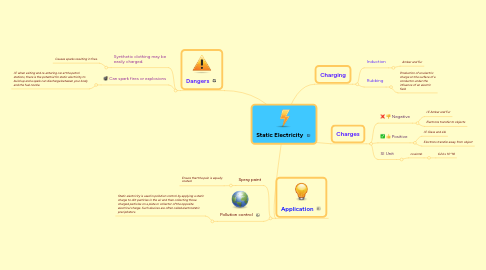
1. Dangers
1.1. Synthetic clothing may be easily charged.
1.1.1. Causes sparks resulting in fires.
1.2. Can spark fires or explosions
1.2.1. I.E when exiting and re-entering car at the petrol stations, there is the potential for static electricity to build up and a spark can discharge between your body and the fuel nozzle.
2. Application
2.1. Spray paint
2.1.1. Ensure that the pain is equally coated.
2.2. Pollution control
2.2.1. Static electricity is used in pollution control by applying a static charge to dirt particles in the air and then collecting those charged particles on a plate or collector of the opposite electrical charge. Such devices are often called electrostatic precipitators.
3. Charges
3.1. Negative
3.1.1. I.E Amber and Fur
3.1.2. Electrons transfer to objects
3.2. Positive
3.2.1. I.E Glass and silk
3.2.2. Electrons transfer away from object
3.3. SI Unit
3.3.1. coulomb
3.3.1.1. 6.24 x 10^18
4. Charging
4.1. Induction
4.1.1. Amber and Fur
4.2. Rubbing
4.2.1. Production of an electric charge on the surface of a conductor under the influence of an electric field
